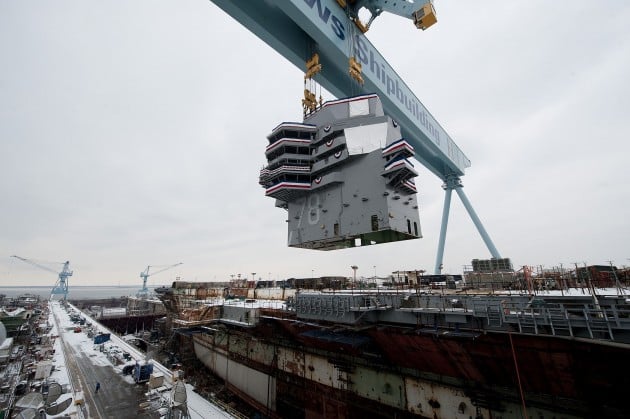Half Of Shipbuilders ‘1 Contract Away’ From Bust: Stackley
By
on March 18, 2015 at 3:26 PM
The nuclear carrier USS Ford (CVN-78) under construction at Newport News Shipbuilding.
WASHINGTON: “About half” of the
are “one contract away” from leaving the business,
told the Senate today. After decades of decline due to foreign competition, the US shipbuilding industry has become so fragile and so dependent on government contracts that the Navy is taking unprecedented and
to share out the work.
“We have several shipyards in our industrial base that are in a very fragile position,” Assistant Secretary of the Navy
told the Senate Armed Services subcommittee on seapower this morning. “We have eight shipyards currently building US Navy ships, and of those eight shipyards, about half of them are about a single contract away from being what I would call ‘not viable.’ In other words, the workload drops below the point at which the shipyard can sustain the investment that it needs to be competitive [and the skilled labor force it needs to function], so they would quickly find themselves outside of the market.”
Sean Stackley (left) and Vice Adm. Joseph Mulloy (right)
The two yards that build nuclear-powered vessels are
not at risk, Stackley emphasized. That would be General Dynamics’
in Connecticut, which builds nuclear submarines, and Huntington-Ingalls Industries’ yard at
, Virginia, which builds not only subs but nuclear-powered aircraft carriers. Those two yards are the only possible builders for the Navy’s top priority programs: the $11 billion to $13 billion
, the $2.7-billion
, and, as of 2021, the $5.2 billion
ballistic missile submarine. If anything, Stackley said, “they’re in a very strong position. In fact, they have
coming their way.”
Nor did Stackley sound too worried about the pair of small yards that build the Littoral Combat Ship,
in Alabama and
in Wisconsin. The Navy is committed to building 52 Littoral Combat Ships of various variants — 20 of them
— and has consistently
.
“
is a contract away,” Stackley said of the San Diego shipyard. “They are in peril.” The survival of the General Dynamics-owned yard requires winning either the first half-dozen of the Navy’s new oilers, supply ships designated T-AO(X), or the big-deck amphibious warship LHA-8, he said. But so does the survival of Huntington-Ingalls’ second shipyard,
in Mississippi: “If Ingalls does not get one of those two major programs, they are at risk.”
Trying to keep both yards in business, while maintaining some semblance of competition to keep down costs, has driven the Navy to a bizarre bundling of contracts. Since NASSCO traditionally build support ships, not warships, while Ingalls builds destroyers and most amphibs, the simple solution would be to allocate the oiler to NASSCO and the amphib to Ingalls. Instead, the Navy is having both yards bid on both ships — along with the right to design a future amphib called LX(R), itself a derivative of the Ingalls LPD-17 class — while keeping other yards out. “We’re going to limit competition to the two shipbuilders that we believe are absolutely essential to our industrial base,” Stackley said.
“That is a strange arrangement… I’m not aware of a past contract that has bundled dissimilar ships like that,” said industry analyst and consultant Loren Thompson. “I frankly don’t understand the acquisition strategy.”
Thompson doesn’t think Ingalls is all that fragile, either. “Ingalls has really done everything right,” he told me. It’s invested heavily in new technology. It’s taken over naval work from its sister yard in
, Louisiana, which now only does commercial projects. And it builds two kinds of warships, amphibs and destroyers, which by shipyard standards is pretty diversified.
In fact, Thompson told me, “I tend to view Ingalls as a stronger shipyard than Newport, even though it’s not nuclear capable, because it’s the newest shipyard in the Western Hemisphere, and it’s got strong support from the local congressional delegation.”
As for NASSCO, Thompson and other observers wonder aloud if it can even build an amphibious ship, something far more complex than the supply ships it’s done in the past. Navy officials repeatedly insist that San Diego yard is raring to go. “NASSCO’s pretty excited [about] the chance to bid on that amphib,” said
, the Deputy Chief of Naval Operations for resources, in a typical statement at yesterday’s McAleese Associates/Credit Suisse conference.
So Ingalls getting the amphib and NASSCO the oilers isn’t a foregone conclusion, the Navy argues. Conversely, if the two ships were competed separately, this logic suggests that one yard could win both, a dangerous blow-out for the loser. The outcome would get even more unpredictable if a third yard were allowed to bid. “If we [did] open competition and soliciting these one at a time, there’s tremendous uncertainty about what the outcome would be,” Stackley told the subcommittee. “Awarding one at a time… puts one of the shipbuilders at risk.”
So complexly intertwined are the fates of the different shipyards that every time Ingalls gets an extra amphibious ship, the Navy has to look at giving additional destroyer work to Bath Iron Works in Maine. That derives from a 13-year-old agreement between the Navy and the yards to balance work between them so as to keep both alive. (“In 2002, both shipyards were in peril,” Stackley said).
While it’s still undecided whether Ingalls gets LHA-8, it is definitely getting
, an additional amphib added to the budget under pressure from Congress. The Navy is looking at “what would be commensurate at BIW to balance that out,” Stackley said. Since LPD-28 won’t be formally awarded until late next year, he said, “we have time and tools available to balance out that agreement with both shipyards.”
(For those of you following along at home, you’re right, this adds up to
seven shipyards — Austal, Bath, Electric Boat, Ingalls, Marinette, NASSCO, and Newport — not eight. After several experts we asked scratched their heads, Navy public affairs dug up the missing eighth:
in Pascagoula, which builds T-AGS oceanographic survey ships).
Is this elaborate balancing really all necessary? Or is Stackley being a little alarmist when he says half the shipyards are on living on the brink?
“Stackley is the sharpest acquisition exec that any service has had for a long time,” Thompson said. “He is simply stating the reality the number of warships the Navy buys is relatively low and even the biggest yards are dependent on programs that can’t tolerate
.”








